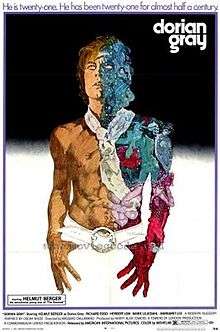Dorian Gray (1970 film)
| Dorian Gray (aka Il dio chiamato Dorian) | |
|---|---|
 Theatrical release poster | |
| Directed by | Massimo Dallamano |
| Produced by |
Samuel Z. Arkoff Harry Alan Towers |
| Written by |
Marcello Coscia Massimo Dallamano Günter Ebert Oscar Wilde (novel) |
| Starring | Helmut Berger, Marie Liljedahl, Herbert Lom, Maria Rohm |
| Music by | Peppino De Luca |
| Cinematography | Otello Spila |
| Edited by |
Leo Jahn Nicholas Wentworth |
Release dates |
|
Running time |
101 min (UK) 93 min (USA) |
| Country |
Italy West Germany United Kingdom |
| Language | English |
Dorian Gray (Italian: Il dio chiamato Dorian) aka The Sins of Dorian Gray is a 1970 movie adaptation of Oscar Wilde's novel The Picture of Dorian Gray starring Helmut Berger. The Italian title translates as A God Called Dorian.
Directed by Massimo Dallamano and produced by Harry Alan Towers, the film stresses the decadence and eroticism of the story and changes the setting to early 1970s London. The sexual liberation of the late 1960s and early 1970s provides a fitting backdrop for Dorian's escapades in this version, and also the general clothing and fashion style of the era is extrapolated into a 1970s version of the aesthetic, decadent world of the 1890s novel.
Critical opinion of the film is decidedly mixed. On the one hand, some consider the film trash and sexploitation,[1] while others point out that the film was shot at a unique time in the 20th century when a new openness about sexuality and its depiction on film allowed showing scenes only vaguely hinted at in the novel and earlier (and also later) movie adaptations.[2] It's interesting to contemplate how this film would've turned out if it had been directed by Jesus Franco, since in 1970, Franco was turning out several films for producer Towers, and this film featured a number of the actors Franco and Towers were working with at the time (Marie Liljedahl, Herbert Lom, Maria Rohm, etc.). Franco was probably too busy filming Count Dracula at the time to direct Dorian Gray as well.
A marked difference between this version and the novel is the final scene. Instead of Dorian slicing the painting with the knife (thereby inadvertently killing himself), he is seen committing suicide with the knife deliberately.
Cast
- Helmut Berger as Dorian Gray
- Richard Todd as Basil Hallward
- Herbert Lom as Henry Wotton
- Marie Liljedahl as Sibyl Vane
- Margaret Lee as Gwendolyn
- Isa Miranda as Frau Ruxton
- Eleonora Rossi Drago as Frau Clouston
- Maria Rohm as Alice Campbell
- Stewart Black as Jim
- Beryl Cunningham as Adrienne